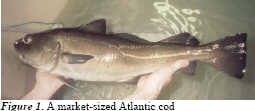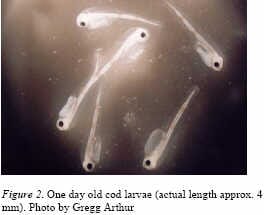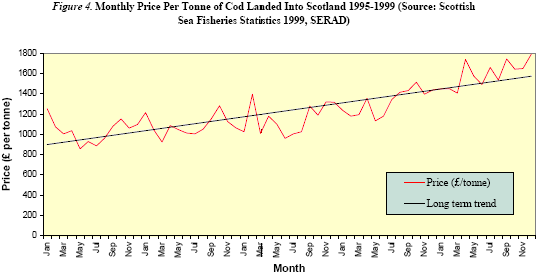
Introduction
Over-exploitation of the wild cod fishery has led to a sharp increase in the market value of cod and has stimulated great interest in the farming of this species. Cod stocks have now declined to unprecedented levels and are now considered to be below safe biological levels in many areas. In response a great deal of research into cod farming has been carried out in Norway, Canada, and the UK. This research has enabled pilot-scale commercial production and low volumes of farmed cod have already reached the UK market. These initial batches of market-sized fish have met with a favourable response from retailers and consumers alike.
 Production methods and practices are rapidly being improved and it is hoped that in the near future a year-round supply of premium quality farmed cod will become available. Cod farming appears to be a good adjunct to existing salmon farming operations.
Production methods and practices are rapidly being improved and it is hoped that in the near future a year-round supply of premium quality farmed cod will become available. Cod farming appears to be a good adjunct to existing salmon farming operations.
This note briefly reviews all aspects of cod farming. However, as cod farming is still in its infancy some of the production methods outlined herein may change, or at least be refined, in the future and interested parties are advised to keep abreast of these developments.
The History of Atlantic Cod Culture
Atlantic cod have been reared in captivity for over 100 years in both Norway and Canada. Up until the 1970s operations aimed solely at producing yolk-sac fry to restock local wild populations. Interest in farming cod to market size developed in Norway in the 1970s and 1980s. In 1977 cod were reared from eggs to mature fish in captive conditions for the first time.
Attempts to produce juvenile cod for on-growing initially centred around semi-intensive mesocosm systems that utilise large enclosures such as saltwater ponds and lagoons. Seawater is pumped into the mesocosm to provide the cod larvae with a source of planktonic food. Variations in the amount and quality
of the plankton, along with the potential for the introduction of diseases has largely curtailed the use of these systems.
The intensive farming of cod began in the mid-1980s although commercial production failed to fulfil its potential due to technical factors notably, the scarcity of juvenile fish for ongrowing and a fall in market price caused by an increased supply of wild caught fish.
The production of sufficient numbers of juveniles remains the biggest problem facing cod farmers. Today, through improved technical knowledge, the industry is much better placed to make commercial-scale cod farming a financially viable proposition.
The Farming Opportunity in Shetland
Cod are naturally found in the waters around Shetland. Indeed, these waters are some of the most productive for this species in the UK. Cod grow well at the seawater temperatures experienced in Shetland which makes it a highly suitable environment for farming this species. Furthermore, as the ongrowing
stage of the cod production cycle is almost identical to that of salmon much of the necessary technology, equipment, infrastructure, and experience is already in place. Shetland, being an established and highly productive fish farming centre, could well become as established and productive for cod as it is for salmon.
The main obstacle to the expansion in Shetland, as it is anywhere else, is the scarcity of sufficient numbers of juvenile fish for on-growing. At least one dedicated hatchery/nursery in Shetland would therefore be required to supply the on-growing units.
The Biology and Life-Cycle of Cod
Atlantic cod are distributed throughout the northern Atlantic, the Baltic sea, and the Barents sea. They are a very adaptable species with separate stocks inhabiting a wide range of environments. In unexploited conditions cod may live for in excess of 30 years and reach a weight in excess of 50 kg.
Scottish stocks spawn in inshore waters during the Spring, usually from February until the end of April. Cod are termed batch-spawners because female cod do not release all of their eggs at one time. Mature females typically produce 15-20 batches of eggs at intervals of 60-75 hours. A single batch may contain several hundred thousand eggs and the total fecundity over the course of the season may be several million. It is not uncommon for a mature wild female to produce 250 eggs per gram of body weight, thus a 4 kg fish could easily produce 1 million eggs. It is thought that the fecundity of farmed cod may
prove to be greater than their wild counterparts.

The eggs are small, typically 1-2 mm in diameter. The time to hatching is temperature and stock dependent but is approximately 10 days at 6-7oC. At hatch the cod larvae are 3.5- 4.5 mm in length and, compared to salmon, are relatively undeveloped (see Figure 2). Initially the larvae feed off of their yolk-sac but after 6-8 days this is used up and the larvae begin to feed on planktonic animals. After approximately 35-40 days the cod undergo metamorphosis after which they become recognisable as fish.
Wild cod become sexually mature between 2 and 7 years old. Age of maturation varies between stocks and is linked to the growth rate of the animal.
Broodstock Management
Adult cod are usually held year-round in onshore tanks although in some instances they are maintained in cages for most of the year and brought onshore a short time before spawning. Tanks are stocked at densities of 5-10 kg/m3 with a ratio of 1:1 to 1:3 females : males.
At the present time, many existing cod hatcheries are using wild-caught broodstock although captive reared fish are now becoming available. This has an advantage in that breeding programs can now be developed with the aim of selecting better performing fish.
The fish are fed either commercially available pellets or a moist sausage consisting of a commercial fishmeal mixed with fish oil and water bound in a collagen skin (the sausages are made on-site using a butchers sausage filling machine). Broodstock diets are of top quality as poor nutrition will result in poor egg quality. Cod cease feeding activity about 1 month prior to the onset of spawning which is a useful indicator for hatchery staff.
It is also very important to minimise all forms of stress to the broodstock as this can result in high numbers of abnormal larvae. The sex and state of sexual maturation of adult cod can be determined quickly and easily with the use of an ultrasound scanner (such as are used to scan unborn babies during pregnancy).
Cod will spawn naturally in tanks and so, unlike salmon, do not need to be stripped of their eggs or sperm. The eggs, which float, can be easily collected in a mesh bag attached to a surface overflow from the tank.
For cod farming to become a commercial reality, a year-round supply of eggs and juveniles is required. The short length of the spawning season is therefore a potential problem. Research in both Norway and Canada has succeeded in producing eggs outside of the natural spawning season through the manipulation of water temperature and day-length (photoperiod). In this way the spawning season can be extended or shifted. Improving protocols that allow year-round production of eggs is one of the main goals of current research into cod broodstock management and looks likely to be achieved within the next few years.
Over the course of the spawning season, the quality of the eggs from any one female cod may decline (as a result of the exhaustion of nutritional reserves) and both producers and buyers should be aware of this.
The Cod Hatchery
Once fertilised eggs have been collected from the broodstock tanks they are disinfected and transferred to incubator tanks. These incubators are cylindrical with conical bottoms (which helps to collect debris). Commonly, 70L incubators are used although larger units have been used with some success. The
eggs are usually kept in darkness with a low inflow (0.3 - 2 L/min) of 6-8oC sea water that has been filtered to 5 microns and sterilised with ultraviolet light. At these temperatures hatching will normally begin 10-14 days later. An estimate of when the eggs will hatch can be made by examining them under a microscope to check the stage of development of the embryo.
The day before the eggs are expected to hatch they are again disinfected and transferred to the larval tanks where first feeding takes place. Various sizes of tank have been used ranging from 100 to 6700 L. Cod are usually stocked at 50-100 larvae/L, although higher stocking densities are achievable provided water quality is maintained at high levels and sufficient amounts of feed are given.
The water temperature is increased gradually from 6-8oC to 10-11oC over several days. The water inflow is provided beneath the surface of the tank water and the flow rate set initially to 0.3-1L/ min depending on tank size. Flow rates are increased as the larvae grow to maintain good water quality although
excessive flow may damage the larvae. There is some disagreement whether larval tanks should be given high or low levels of light and this may well be stock dependent. Regardless of the intensity, light should be given continuously throughout the larval stage.
Algae, grown in intensive culture in the hatchery, is also added to the larval tanks. There are many possible reasons why algae is required and it is generally accepted as essential for successfully rearing cod larvae.
Initially the larvae are too small and undeveloped to feed upon commercial pellets, or inert diets as they are also known. Planktonic prey animals such as rotifers and brine shrimp, Artemia, are cultured in the hatchery and used as a food source. The timing of the introduction of each type of feed varies with
the growth rate of the larvae and between hatcheries, an approximate outline of the timing is given in Figure 3. In general, rotifers are fed from the day the larvae hatch. It is essential for the larvae to start feeding on these organisms before their yolk-sac reserves are used up (circa 6-8 days post
hatching) otherwise starvation and mass mortality will result.
When the larvae have reached a sufficient size and stage of development Artemia are introduced. These are larger than rotifers and are more suitable for the growing larvae. Rotifers should continue to be fed to for 5-7 days after the introduction of Artemia to allow the larvae sufficient time to adjust. Neither rotifers or Artemia are nutritionally sufficient to sustain the cod larvae and they must therefore be enriched (i.e. fed) with commercially available supplements. The type and application of these enrichments can be crucial to the success of a hatchery.
Weaning onto formulated inert diets begins approximately 35- 40 days post hatch whilst Artemia are still being fed. Recent evidence suggests it is possible to wean earlier a significant improvement since live feed production is very costly. Survival rates are affected by outbreaks of bacterial diseases, notably Vibriosis, and parasites although appropriate treatments are effective. Good hygiene helps to prevent these outbreaks. Despite overcoming many of the problems encountered during the hatchery stage, survival through to weaning is commonly only 5-25% although this figure is improving as better practices
are developed.
The Nursery Stage
Juvenile cod are not ready to be stocked into sea cage sites until they are approximately 6-7 months old (20-50g) and so are grown-on from weaning to the required size in the hatchery. The equipment and techniques used in the nursery are similar to those used for salmon fry/pre-smolts.
The major challenge for producers during the nursery stage is preventing cannibalism. Cod are extremely cannibalistic between 2 and 4 months old. The effects of this can be very serious if left unchecked. Frequent grading (using a standard bar grader and starting with a 3mm grid) and provision of sufficient
qualities of feed of the appropriate size will go a long way to solving this problem.
On-growing
Cod can be successfully reared in standard salmon cages and so existing salmon sites could potentially be utilised for cod production with little or no capital investment. Very high energy sites should be avoided as should shallow areas with large fluctuations in temperature. A temperature range of 6-
12oC is considered optimal. Converting an existing salmon site over to cod production should only require minor changes to the discharge consent, but, as current SERAD guidelines oppose the farming of more than one species at a site, the site should be given over totally to cod production.
Husbandry practices during the on-growing stage are similar, if not identical to those for salmon. It has been shown that cod can perform well at stocking densities of 40 kg/m3. Market-size for farmed cod is the same as for wild fish being between 2-5 kg. This would require an on-growing phase of 18- 28 months dependent on fish size.
Pelleted feeds for cod are already available from some of the major UK feed manufacturers. Growth performance is considered good with food conversion ratios of 1:1 being reported. These diets have a lower oil content (approximately 12-13%) than salmon diets (e.g. 38%) as excess fat levels in the
feed lead to the cod developing enlarged livers which can account for over 10% of the total body weight. This represents a significant reduction in the edible yield of the fish.
Improvements in diet formulation will mitigate the extent of this problem. Interestingly, cod liver oil, which is in itself a high value commodity, may be a potential by-product from cod farming. The marketability of farmed cod liver oil will depend on the chemical composition being identical that of cod liver oil from wild fish.
Because farmed cod experience high growth rates they tend to mature earlier than wild fish. This may occur prior to reaching market-size with a consequent loss of performance and condition. Research has shown that this may be prevented with the use of lights as used in salmon farming to delay grilsing.
While this method has not yet been fully developed it is expected to be perfected within the next couple of years.

During the on-growing stage, cod are susceptible to a number of pathogens. Vibriosis has proved to be a problem although vaccines have been developed in Norway and Canada. Cod can also experience problems with sea lice (Caligus spp.) which can be treated in much the same manner as for salmon. While wild cod are prone to infestations of tapeworms and roundworms, initial experience with farmed cod shows either a very low incidence or complete absence of these organisms. This is a definite advantage for farmed cod both in terms of growth performance and, more importantly, for sales and marketing.
Economics and Marketing
The two driving forces behind developing a new species for aquaculture are unit price and volume. There is a large and established market for cod in the UK and abroad. In 1998 the UK market for cod was calculated at 170,000 tonnes of which 65% was imported. Demand is primarily for fillets although larger fish in the 3-5 kg range could provide steaks.
The decline in wild-catches has resulted in a long term increase in prices, the unit price of landings into Scotland increased by over 75% between 1995 and 1999 (see Figure 4). Current retail prices are around 9/kg.
While only small amounts of farmed cod have been produced in the UK (an estimated 26 tonnes in 2000) production in the next ten years is forecast to increase dramatically. Obviously the volume of production will affect prices directly. It is believed that while production volume is low cod can be marketed at
premium prices in niche markets but that as volume increases prices will inevitably fall. Increases in the supply of wild-caught cod would also have an effect on market price. In the past this factor has prevented cod farming from becoming established.
Should wild-stocks fail to recover as has been predicted then it would appear that the prices of farmed cod could remain strong. Current thinking is that cod farming is viable provided certain economic conditions are met notably: juvenile production costs are reduced; existing salmon infrastructures are utilised, and the scarcity of wild cod and the quality of farmed fish guarantee premium prices. Farmed cod has further advantages over its wild counterpart in terms of freedom from parasites, year-round supply, traceability, and freshness which should ensure a good demand for this product.

Acknowledgements
This Information Note was funded by Shetland Enterprise and the Shetland Islands Council. The author would like to thank the following people who provided help and advice in writing this information note: Dr Terje Van Der Meeren, Mr Nick Fullerton, Dr Joseph Brown, Mr Danny Boyce, Dr Chris Cutts, Dr Lesley McEvoy, and Mr Gregg Arthur. In the interests of saving space no references have been cited in this information note, however, a full reference list is available from the author on request.
Source: North Atlantic Fisheries College - March 2006


